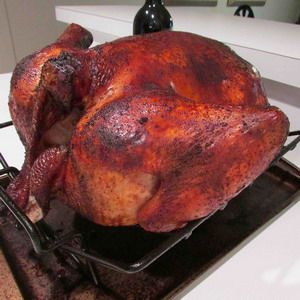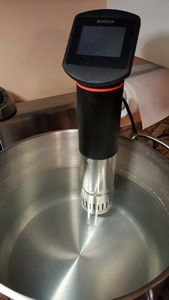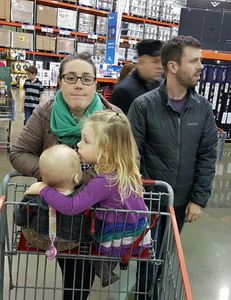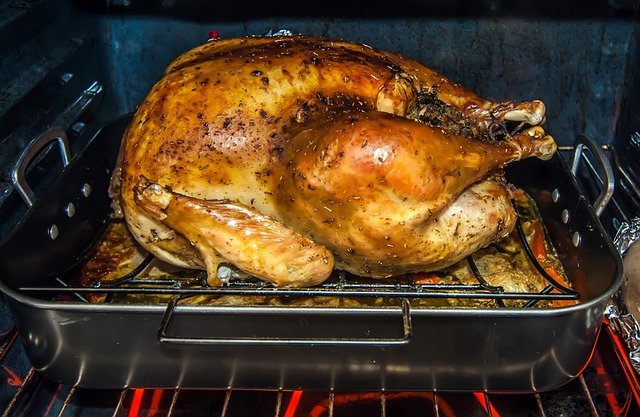
Every year the children, grandchildren, and now great grandchildren of my maternal grandmother get together for a Thanksgiving feast. The location of the feast rotates around between the various households with this year’s feast appearing at my mother’s house. Since she is 85 years old my sisters decided that she needed help with the feast and somehow in the process I got tasked with providing the turkey.
The format of the gathering is a big potluck with the host house providing the turkey and the tables, chairs, place settings, etcetera. A couple years ago Ellen and I hosted Thanksgiving at our place. Back then I had just gotten a Traeger pellet smoker/grill and did the turkey in that. It went over well and a month ago my mother asked if I could bring the grill up to her place for doing the turkey at her house. I pointed out that the grill did not fit into anybody’s car, but that I could cook the turkey the day before – so I guess technically I volunteered to do the turkey.

Well a couple weeks ago I decided to do a trial run on a turkey and cook half of it on the grill and the other half I would cook using my new passion – sous vide cooking.
What is sous vide? Sous vide is a way to cook food to a very exact temperature by vacuum sealing the food in a food safe plastic bag and cooking the food in a water bath that is carefully kept at an exact temperature. Every food has a different temperature that is perfect for cooking it. Meats especially are very sensitive to temperature. At a certain temperature the meat fibers shrink up and release the water attached to them. The goal of sous vide cooking of meats is to keep the meat temperature below this shrinking point so that the meat will retain all its juiciness and flavor yet still be fully cooked.

Most meats are recommended to be cooked to an internal temperature designed to kill bacteria. Usually this temperature is high enough destroy the natural tenderness of the meat. The secret is that the recommended temperatures are set high so that only a minute or two at that temperature will kill bacteria. What most people don’t know is that the temperature does not need to be that high if you keep the food at the temperature of longer periods of time. You can do very low temperature cooking safely by just cooking long enough. For instance beef is recommended to be raised to 160 degrees, yet 135 degrees works just as well if the food is kept at that temperature for an hour.

I have played with low temperature meat cooking for years with my crock-pot set on warm. Sous vide simply takes this concept and turns it into a science. Very specific temperatures and times have been worked out by top chefs all over the world for every food imaginable. One of the reasons restaurants have embraced sous vide is not only is the food amazing, but the food can be cooked and kept at the desired temperature for a long time without degrading the final outcome. This works out well for restaurants that want to pre-prepare foods for the dinner rush. The food gets to the table quickly, perfectly cooked and super delicious.
Now with meats, the chef will generally toss the sous-vide-prepared cut of meat on the grill for a minute on each side to give the meat a nice browning, since low temperature cooking will not brown the meats. But for those of you wanting the ultimate in healthy meat eating, avoiding the browning step will avoid all the carcinogenic compounds that form from high temperatures browning of meats, plus the meat is tenderer and therefore much more easily digested. Easy digestion means greater nutrition and less stress on the digestive tract.

So what do you need to do sous vide cooking? You need a really big cooking pot to serve as the water bath. I bought an 18 quart stock pot. And you need a sous vide water heating and circulating device that will keep the water temperature to within 1 degree of your desired temperature. Lastly you need both a food grade vacuum food sealer and bags. Or for the beginner you can just use Zip-Lock plastic bags that you squeeze all the air out of by submersing the food item in the bag into the water with the top still open and let the water push the air out of the bag. Once the air is out just zip seal the bag closed. The air has to be out of the bag so that the bag of food will submerge into the water bath and not float on top of the water.

Turkey is interesting because the dark meat needs to be cooked at a higher temperature than the white meat. With traditional cooking methods, by the time the dark meat is fully cooked, the white meat is over cooked and dried out. But with sous vide I am cooking the dark meat separately from the white meat. So my first step is to de-bone the turkey and separate the thigh and leg pieces from the breast pieces. In my case I placed the right and left breast pieces into separate bags and placed the right and left leg/thigh pieces into separate bags. To keep all the bags approximately the same size I also placed one wing piece in with each leg.

In the case of turkey, the breast is cooked at 148 degrees for 1.5 to 2 hours and the leg/thigh pieces are cooked at 154 degrees for 2 to 3 hours. For efficiency I cooked the breast pieces first then raised the temperature to cook the legs and thighs. While those are cooking in the water bath I take all the left over pieces of back bone, breast bone, giblets, and extra pieces of fat and skin and put them into a pyrex casserole pan to bake in the oven at 400 degrees to draw out all the juices and melt out the fat. This is what I will be using to make the gluten free gravy, since the main pieces of meat won’t have any drippings to speak of.

I am cooking the turkey sous vide the day before Thanksgiving. Then Thanksgiving morning I am going to fry the cooked pieces for just a minute on each side in a cast iron skillet I inherited from my Dad. This last step is because the turkey is soft and pale looking coming out of the cooking bags. Frying in some nice organic palm oil will put a nice brown to the outside of the turkey without really affecting the meat on the inside. As I say I am only browning the pieces for a minute on each side.

As I write this it is the night before Thanksgiving. I have spent the day with my son and daughter-in-law and my two grandkids. They flew in from Seattle early this morning and have spent the day making pies for the feast tomorrow. In between all this I got to play with my new grandson Owen and my granddaughter Eliza. I made them almond meal waffles for breakfast with homemade yogurt and homemade persimmon jam. For lunch we threw together a delicious chili relleno casserole made with Diaya cheese.

Tomorrow is the big day where I get to find out if everyone else likes the sous vide way of cooking turkey as much as I do. We shall see. By the time you get this newsletter, Thanksgiving will hopefully be a pleasant memory and your tummy will have hopefully recovered from the feast by now.
